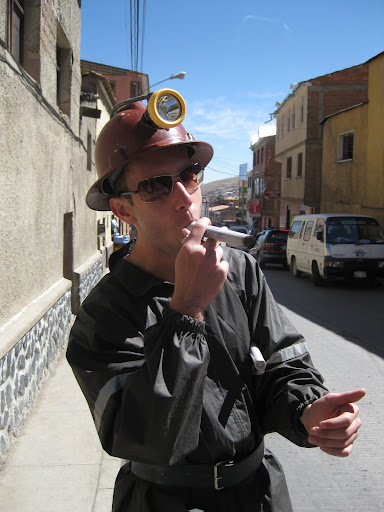 This is our buddy, Jeff. He’s much more intelligent than he looks in this photo, where he has lit a piece of dynamite on fire and is pretending to smoke it. In reality, there is no danger of this dynamite blowing up, as it requires a few other ignition components to explode. So, our guide told anybody who wanted to smoke some dynamite to go ahead and do so. Jeff was our guinea pig.
This is our buddy, Jeff. He’s much more intelligent than he looks in this photo, where he has lit a piece of dynamite on fire and is pretending to smoke it. In reality, there is no danger of this dynamite blowing up, as it requires a few other ignition components to explode. So, our guide told anybody who wanted to smoke some dynamite to go ahead and do so. Jeff was our guinea pig.
Jeff, his girlfriend Romy, and I are on Potosi’s most popular activity – a tour of the mines that have made the city famous. For over 500 years, the big mountain looming over the city has housed some of South America’s most valuable minerals, including the largest deposit of silver on the continent. The silver is now long gone, but mining continues to be a mainstay of the local economy, and former miners are now running tours into the working mines.
I have to admit, I was a little reluctant to check it out (so was Sarah – she chose not to go). The mine tours are a bit controversial – portrayed by some as a voyeuristic opportunity to see how bad people have it. And, it’s not the safest tour ever – it’s a working mine and accidents do happen (in fact, millions of people have died in these mines over the past 500 years, but largely due to the slave labor and inhumane conditions of years past). But in the end, I heard enough positive endorsements to give it a try.
 After getting outfitted in all the appropriate gear (boots, jackets, pants, hard hats, lamps), we first stopped at the miners market. The only place on the continent where you can buy dynamite and coca leaves with no questions asked, the miners market is where miners go to get supplies, and tourists go to smoke dynamite.
After getting outfitted in all the appropriate gear (boots, jackets, pants, hard hats, lamps), we first stopped at the miners market. The only place on the continent where you can buy dynamite and coca leaves with no questions asked, the miners market is where miners go to get supplies, and tourists go to smoke dynamite.
Entering the mine feels like a passageway into middle earth. Twenty yards in, it’s already dark, damp, dirty, and hot. The deeper you go, the hotter it gets. There is no ventilation within (hence the very early death of nearly everyone who puts in more than a few years working here), but air pipes do hang from the ceiling to power the drills far below. We did our best to avoid touching the walls, as asbestos dripped from the ceiling in colorful but toxic stalactites. After basically rock climbing up to the 2nd level, we met some miners who showed us the process of preparing dynamite for a blast, and the minerals that they recovered to pay their wages. We also got to meet the Tio, the devil statue that exists within each mine who receives prayers and offerings from miners in search of safety from day to day.
In the end, I was happy to see it, but I didn’t feel good about it. While miners do reap well-deserved benefits from tourist visits, the voyeuristic nature of the tour was unsettling. But the miners are very proud of their work and their profession, and there is no shame in the work or the conditions they endure. In fact, they are proud to show it off, and happy to make an extra buck as well.
We had one day in Tupiza, Bolivia before we headed out on the much talked-about salt flat tour, so we decided to do a little horseback riding with our new South African friends, Jeff and Romy.